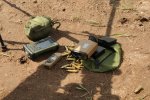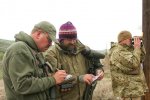I was present when Trijicon tested the CCAS,
This is fully electronic and was designed to replace a lot of what they called advanced skills.
The Trijicon CCAS accurately computes a corrected aiming point based on current
environmental conditions using known ballistic equations instead of the common
G1 table averages typically used by the majority of ballistic modeling programs. The
CCAS calculates for pressure, angle, range and movement of the target, automatically
adjusting for changes in relation to the zeroing set-up to provide updated aiming
solutions. With the capability of supporting multiple weapons and multiple projectiles
per weapon it provides increased first round hit capabilities. The CCAS replaces the
necessity for advanced marksmanship skills such as range estimation, windage
adjustment and angle of fire adjustment.
Yes it does wind, and range with a single button push and the demos we did with the scientist creating this device were eye opening.
There were 5 scientist, none had any marksmanship or shooting skills to speak of. In fact one said, "the satellite I worked on launched last week so I am on this project now" We handed them an M4 with an ACOG on it and moved them back from 100 to 600 yards UKD style, just stopping and letting them shoot at a full IPSC Target (Paper) for score. Out of 20 shots they averaged 7 hits or so among the group. We added the prototype CCAS to the mix and they hit 18 out of 20... That is what technology can do...
Still the unit has the same reticle as the standard Trijicon ACOG so if the unit breaks it is not a brick, it is just a big ACOG.
It's silly to point to "what if's" or point to something that took place in 1952... we all know good and well Soldiers of any era will adapt to the situation and really fast. Electronics are not the same as in Vietnam and we have quick detach bipods that can be removed. (frankly I don't know what precision rifle bipod was being used in 1968, I dont' recall the military using any bipods until the early 1990s. I know in the USMC we never had bipods or even a method to attach one on an M40A1. I deployed to Korea, the Philippines and went on live patrols when Col Rowe was killed hunting the NPA. I know what the vines do and personally I had not issue with them grabbing the rifle more than they grabbed anything else. The Laser Range Finders in the military are pretty darn tough, they are not anything like the commercial models hunters use. Most electronics have evolved to adapt... I noted before, my brother's company has had their batteries in Antarctica the only question is how long you want them to work and how many you want to carry. But guys can take non-mil-spec camera equipment around the world to film, I think we can manage to bring a laser, pda and kestrel.
What if Aliens land and knock out every GPS satellite while exploding an EMP over the Earth, do you think we will not adapt, and quite quickly ? Most situation, especially combat tend to be much closer than you realize where on a Minute of Man target the deviations are not so great to say, that won't work. The average range is like 400 yard and in, urban settings are even closer. Take your commercial laser unit to any city with more than 3 street lights and see how far you can actually operate, line of sight. Not much.
How do you think a good shooter used to target shooting on a square range with flags and yard lines manages to hit stuff in the field ? It's not magic, it's just adaptation. Back in the day when I guy said, "that looks like 450 yards, how close do you think he was ? Clearly close enough to learn if it didn't hit he had two choices, the shot went high or it went low. He adjusts and learns from his mistake. ( Look at Saving Private Ryan which is playing in heavy rotation, he guessed on the range to the sniper and hit him through the scope) The stories certainly get condensed and sound better in the retelling but they certainly didn't make work in a single go because of experience. There was very limited schools back then, very limited education on the subject. You said, Private Johnson you shoot good, here is a scope. Do you think Private Johnson in 1944 knew the first thing about a scope he was handed prior to the Normandy Invasion ? Of course not, he probably never saw a scope except in a Life Magazine. Old School, does not mean well educated school, but more trial and error... you never hear about the trials or the errors only the successes.



